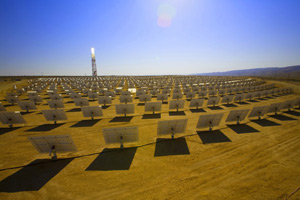BrightSource wins commercial solar contract in South Africa
 With nearly 4 gigawatts of solar contracts to dole out, South Africa is a hot market right now. No wonder it’s looking to BrightSource Energy to develop solar thermal electricity. The California-based company announced Feb. 2 that it won its first commercial agreement in South Africa.
With nearly 4 gigawatts of solar contracts to dole out, South Africa is a hot market right now. No wonder it’s looking to BrightSource Energy to develop solar thermal electricity. The California-based company announced Feb. 2 that it won its first commercial agreement in South Africa.
The contract with BrightSource is one of many contracts in the works. South Africa announced last year that it was making a significant shift to renewable energy over the next few years, planning to install 3,725 megawatts of renewable energy by 2016. It’s an effort by the country to get off coal, which now supplies more than 85 percent of the country’s energy needs.
Over the next 20 years, South Africa’s energy needs are expected to double to more than 85 gigawatts. During that period, the country plans to add in 18 gigawatts or 18,000 megawatts of renewable energy. South Africa's Renewable Energy Independent Power Producer Procurement Program, under its Department of Energy, will coordinate the country’s efforts to get off coal.
Under the agreement with Sasol, BrightSource and its partner will conduct a Front End Engineering & Design (FEED) study.
“FEED study is a critical step in the design and deployment of a solar thermal power plant,” said BrightSource spokesperson Kristin Hunter. “Sasol will use the information from the study to determine how best to deploy BrightSource’s technology in South Africa.”
BrightSource’s technology consists of concentrated solar power using heliostat fields to concentrate sunlight on a centralized tower, producing superheated steam.
The steam can power a conventional generator or be used for other processes, like fracking.
The company is developing solar thermal tower systems capable of producing 250 megawatts of electricity using its LPT technology. Its biggest named project to date is the 750-megawatt Rio Mesa project in California’s Riverside County.
The technology includes thermal storage, allowing the systems to continue operating under cloudy conditions or into the evening.



